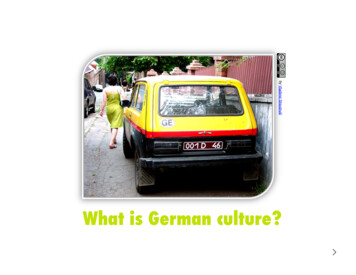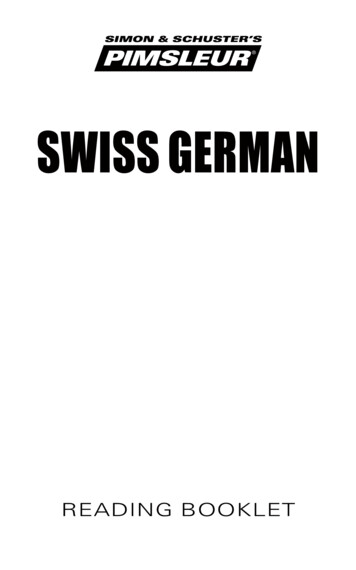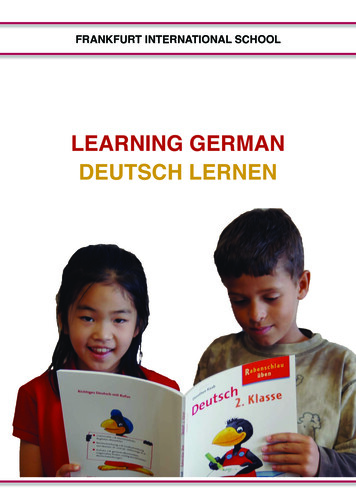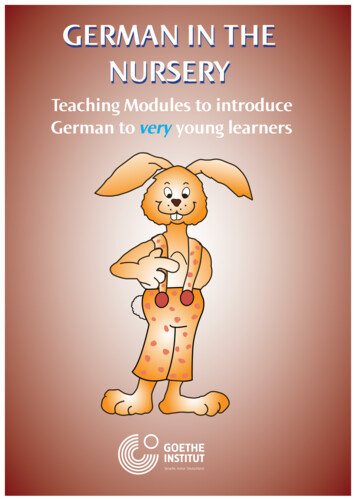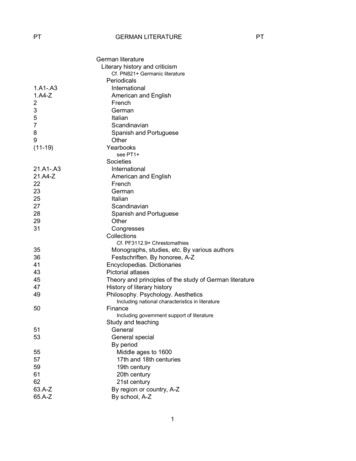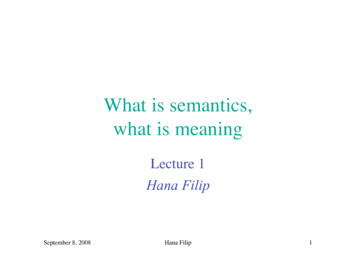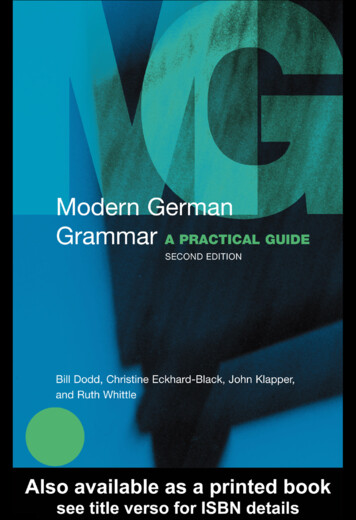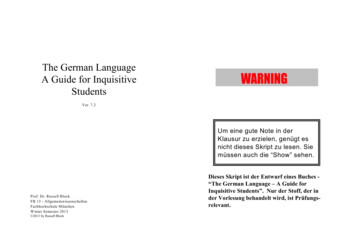
Transcription
The German LanguageA Guide for InquisitiveStudentsVer. 7.2Um eine gute Note in derKlausur zu erzielen, genügt esnicht dieses Skript zu lesen. Siemüssen auch die “Show” sehen.Prof. Dr. Russell BlockFB 13 - AllgemeinwissenschaftenFachhochschule MünchenW inter Semester 2013 2013 by Russell BlockDieses Skript ist der Entwurf eines Buches “The German Language – A Guide forInquisitive Students”. Nur der Stoff, der inder Vorlesung behandelt wird, ist Prüfungsrelevant.
ContentsChapter 1: Discovering the German Language . . . . . . . . . . . . . . -11German as an area of inquiry . . . . . . . . . . . . . . . . . . . . . . . . . -1-Chapter 2: The Sound of German . . . . . . . . . . . . . . . . . . . . . . . . . -32The standard dialect . . . . . . . . . . . . . . . . . . . . . . . . . . . . . . . . -3-3Overview of the German consonants . . . . . . . . . . . . . . . . . . .3.1 Contrasts between voiced and voiceless sounds . . . . . . .3.2 Tense vs. lax . . . . . . . . . . . . . . . . . . . . . . . . . . . . . . . . .3.3 Comments on individual consonants . . . . . . . . . . . . . . . .3.3.1Vogel-V . . . . . . . . . . . . . . . . . . . . . . . . . . . . . .3.3.2The strange case of /s/ . . . . . . . . . . . . . . . . . . .3.3.3r-peculiarities . . . . . . . . . . . . . . . . . . . . . . . . . .3.3.4The origin of w . . . . . . . . . . . . . . . . . . . . . . .3.3.5Foreign sounds . . . . . . . . . . . . . . . . . . . . . . . . .3.3.6The glottal stop . . . . . . . . . . . . . . . . . . . . . . . . .4Vowels . . . . . . . . . . . . . . . . . . . . . . . . . . . . . . . . . . . . . . . . . . -8-5The German vowels . . . . . . . . . . . . . . . . . . . . . . . . . . . . . . . -105.1 Vowel length . . . . . . . . . . . . . . . . . . . . . . . . . . . . . . . . . -11-6Accentuation and rhythm . . . . . . . . . . . . . . . . . . . . . . . . . . . -116.1 Stress timing . . . . . . . . . . . . . . . . . . . . . . . . . . . . . . . . . -12--3-4-5-5-5-7-7-7-8-8-Chapter 3: Sound Change . . . . . . . . . . . . . . . . . . . . . . . . . . . . . . -151Sound change . . . . . . . . . . . . . . . . . . . . . . . . . . . . . . . . . . . . -15-2Evidence for sound change . . . . . . . . . . . . . . . . .2.1 Conservative Spelling . . . . . . . . . . . . . . . . . .2.2 Misspellings as evidence of sound change . .2.3 Rhymes as evidence of sound change . . . . . .2.4 Expert opinions . . . . . . . . . . . . . . . . . . . . . . .2.5 Loan words . . . . . . . . . . . . . . . . . . . . . . . . . .-15-15-16-16-16-17-
2.5.1Dialects . . . . . . . . . . . . . . . . . . . . . . . . . . . . .2.6 Kinds of sound change . . . . . . . . . . . . . . . . . . . . . . . . .2.7 Loss of sound . . . . . . . . . . . . . . . . . . . . . . . . . . . . . . . .2.8 Addition of sound . . . . . . . . . . . . . . . . . . . . . . . . . . . .2.9 Assimilation . . . . . . . . . . . . . . . . . . . . . . . . . . . . . . . . .2.10Dissimilation . . . . . . . . . . . . . . . . . . . . . . . . . . . . .2.11Lengthening . . . . . . . . . . . . . . . . . . . . . . . . . . . . .2.12Shortening . . . . . . . . . . . . . . . . . . . . . . . . . . . . . . .Rounding . . . . . . . . . . . . . . . . . . . . . . . . . . . . . . . . . . . . . . .2.14Unrounding . . . . . . . . . . . . . . . . . . . . . . . . . . . . . .2.15Retraction . . . . . . . . . . . . . . . . . . . . . . . . . . . . . . .2.16Metathesis . . . . . . . . . . . . . . . . . . . . . . . . . . . . . . .2.17Breaking . . . . . . . . . . . . . . . . . . . . . . . . . . . . . . . .2.18Smoothing . . . . . . . . . . . . . . . . . . . . . . . . . . . . . . .2.19Umlaut . . . . . . . . . . . . . . . . . . . . . . . . . . . . . . . . .2.20Ablaut . . . . . . . . . . . . . . . . . . . . . . . . . . . . . . . . . .2.21Vowel harmony . . . . . . . . . . . . . . . . . . . . . . . . . . .2.22Laxing . . . . . . . . . . . . . . . . . . . . . . . . . . . . . . . . . .2.23Tensing . . . . . . . . . . . . . . . . . . . . . . . . . . . . . . . . .2.24Palatalization . . . . . . . . . . . . . . . . . . . . . . . . . . . .2.25Nasalization . . . . . . . . . . . . . . . . . . . . . . . . . . . . .2.26How does sound change take place? . . . . . . . . . . .2.27Is sound change regular? . . . . . . . . . . . . . . . . . . . .2.28Standard languages . . . . . . . . . . . . . . . . . . . . . . . .2.29Limited time for application . . . . . . . . . . . . . . . . .2.30Analogy . . . . . . . . . . . . . . . . . . . . . . . . . . . . . . . .2.31Ousting . . . . . . . . . . . . . . . . . . . . . . . . . . . . . . . . .2.32Substitution through borrowing . . . . . . . . . . . . . .2.33Functional explanation . . . . . . . . . . . . . . . . . . . . .2.33.1 The Slavic genitive-accusative . . . . . . . . . . .2.33.2 English word order . . . . . . . . . . . . . . . . . . . .2.33.3 Alternative explanation . . . . . . . . . . . . . . . . .2.34Language mixture . . . . . . . . . . . . . . . . . . . . . . . . 8-Semantic change . . . . . . . . . . . . . . . . . . . . . . . . . . . . . . . . . -403.1 Types of semantic change . . . . . . . . . . . . . . . . . . . . . . -403.1.1Narrowing . . . . . . . . . . . . . . . . . . . . . . . . . . . -40--v-3.1.2Broadening . . . . . . . . . . . . . . . . . . . . . . . . . . .3.1.3Elevation . . . . . . . . . . . . . . . . . . . . . . . . . . . . .3.1.4Denigration . . . . . . . . . . . . . . . . . . . . . . . . . . .3.1.5Transfer . . . . . . . . . . . . . . . . . . . . . . . . . . . . .3.1.6Hyperbole . . . . . . . . . . . . . . . . . . . . . . . . . . . .3.1.7Litotes . . . . . . . . . . . . . . . . . . . . . . . . . . . . . .3.1.8Metaphor . . . . . . . . . . . . . . . . . . . . . . . . . . . .3.2 The etymologist’s method . . . . . . . . . . . . . . . . . . . . . . .3.3 How close is close enough? . . . . . . . . . . . . . . . . . . . . .-41-41-41-41-42-42-42-42-44-Chapter 4: The Comparative Method I - English and German. . . . . . . . . . . . . . . . . . . . . . . . . . . . . . . . . . . . . . . . . . . . . . . -451English and German . . . . . . . . . . . . . . . . . . . . . . . . . . . . . . . -45-2Obvious similarities . . . . . . . . . . . . . . . . . . . . . . . . . . . . . . . -45-3Patterned correspondences . . . . . . . . . . . . . . . . . . . . . . . . . -46-4W ords related in meaning . . . . . . . . . . . . . . . . . . . . . . . . . . -47-5Historical records . . . . . . . . . . . . . . . . . . . . . . . . . . . . . . . . . -48-6Similarities in inflection . . . . . . . . . . . . . . . . . . . . . . . . . . . . -49-7Parallels in syntax (‘Satzbau’) . . . . . . . . . . . . . . . . . . . . . . . -507.1 German and English syntax . . . . . . . . . . . . . . . . . . . . . . -517.2 English and German – Affectionate Sisters . . . . . . . . . . -53-8Direction of change . . . . . . . . . . . . . . . . . . . . . . . . . . . . . . . -53-Chapter 5 : The Comparative Method II – Researching the Past. . . . . . . . . . . . . . . . . . . . . . . . . . . . . . . . . . . . . . . . . . . . . . . -571Finding the apples - which languages to compare . . . . . . . . -571.1 Geography . . . . . . . . . . . . . . . . . . . . . . . . . . . . . . . . . . -571.2 The meaning bridge . . . . . . . . . . . . . . . . . . . . . . . . . . . -57--vi-
2Early attempts . . . . . . . . . . . . . . . . . . . . . . . . . . . . . . . . . . . -61-3The breakthrough . . . . . . . . . . . . . . . . . . . . . . . . . . . . . . . . -64-4Mother – Proto-Indo-European (‘Urindogermanisch’). . . . . . . . . . . . . . . . . . . . . . . . . . . . . . . . . . . . . . . . . . . . . . -704.1 The method . . . . . . . . . . . . . . . . . . . . . . . . . . . . . . . . . -70-4Natural and grammatical gender in German . . . . . . . . . . . . . -89-5Of maidens and turnips - rules for German gender . . . . . . . -905.1 Semantic classes . . . . . . . . . . . . . . . . . . . . . . . . . . . . . . -91-7.Gender of foreign words . . . . . . . . .7.1 Gender from source language .7.1.1Masculine . . . . . . . . .7.1.2Feminine . . . . . . . . . .7.1.3Neuter . . . . . . . . . . . . .7.2 Gender from other sources . . . .7.3 Problems of composition . . . . .8W ords with two genders . . . . . . . . . . . . . . . . . . . . . . . . . . . -103-9Gender mobility . . . . . . . . . . . . . . . . . . . . . . . . . . . . . . . . . -1069.2 Gender mobility through the adjective declension. . . . . . . . . . . . . . . . . . . . . . . . . . . . . . . . . . . . . . . . . . -109-Chapter 6 : The German Noun - Seven Ways to Form the Plural. . . . . . . . . . . . . . . . . . . . . . . . . . . . . . . . . . . . . . . . . . . . . . -731The German plural . . . . . . . . . . . . . . . . . . . . . . . . . . . . . . .1.1 The weakening of inflectional endings . . . . . . . . . . . . .1.2 Umlaut – o-stems and i-stems . . . . . . . . . . . . . . . . . .1.3 Feminine abstract nouns in § . . . . . . . . . . . . . . . . . . . .1.4 Minor groups . . . . . . . . . . . . . . . . . . . . . . . . . . . . . . . .1.5 The “weak” declension . . . . . . . . . . . . . . . . . . . . . . . .1.6 The s-stems . . . . . . . . . . . . . . . . . . . . . . . . . . . . . . . . .relationships . . . . . . . . . . . . . . . . . . . . . . . . . . . . . . . . . . . .1.8 Root nouns (consonantal declension) . . . . . . . . . . . . .1.9 The -s plural . . . . . . . . . . . . . . . . . . . . . . . . . . . . . . . . .1.10The German noun declension – first aid . . . . . . . .-73-73-74-76-76-76-78-79-80-80-80-Gender and domination . . . . . . . . . . . . . . . . . . . . . . . . . . . . -83-2Natural and grammatical gender . . . . . . . . . . . . . . . . . . . . . -83-3W here does gender come from? . . . . . . .3.1 Nomen est omen . . . . . . . . . . . . . . .3.2 Problems of evidence . . . . . . . . . . . .3.3 Gender and classifiers . . . . . . . . . . .3.4 Determinatives and classifiers . . . . .3.5 The decline and fall of the 1-101-101-102-Chapter 8: Case . . . . . . . . . . . . . . . . . . . . . . . . . . . . . . . . . . . . . -1111The1.11.21.31.41.5meaning of “case” . . . . . . . . . . . . . . . . . . . . . . . . . . . .Case alone . . . . . . . . . . . . . . . . . . . . . . . . . . . . . . . . . .Case syncretism . . . . . . . . . . . . . . . . . . . . . . . . . . . . . .Physical case and metaphoric case . . . . . . . . . . . . . . .Metaphoric case . . . . . . . . . . . . . . . . . . . . . . . . . . . . .W here do little prepositions come from? . . . . . . . . . .-111-112-113-113-115-116-2Case with verbs . . . . . . . . . . . . . . . . . . . . . . . . . . . . . . . . .2.1 Verbs with the dative . . . . . . . . . . . . . . . . . . . . . . . . .2.2 Verbs with the genitive . . . . . . . . . . . . . . . . . . . . . . . .2.3 The accusative alone . . . . . . . . . . . . . . . . . . . . . . . . . .-117-117-118-118-Chapter 7: Gender . . . . . . . . . . . . . . . . . . . . . . . . . . . . . . . . . . . -831.Chapter 9: The Verb - Strong and W eak . . . . . . . . . . . . . . . . . . -1191Primary and secondary verbs . . . . . . . . . . . . . . . . . . . . . . . -119--viii-
2The strong (ablauting) verbs . . . . . . . . . . . . . . . . . . . . . . . -119-3The preterite-present verbs . . . . . . . . . . . . . . . . . . . . . . . . -127-4Personal endings and vowel harmony . . . . . . . . . . . . . . . . -1274.1 The modern verb endings . . . . . . . . . . . . . . . . . . . . . . -129-5“Grammatischer W echsel” . . . . . . . . . . . . . . . . . . . . . . . . -130-6Me, me, me! . . . . . . . . . . . . . . . . . . . . . . . . . . . . . . . . . . . -131-7The “weak” verbs . . . . . . . . . . . . . . . . . . . . . . . . . . . . . . . -132-8The8.18.28.38.48.58.64Syntax vs. etymology . . . . . . . . . . . . . . . . . . . . . . . . . . . . .4.1 Co-occurrence: determiner and weak adjective . . . . .4.2 Relative clauses and the Hittite connection . . . . . . . . .4.3 A small distraction . . . . . . . . . . . . . . . . . . . . . . . . . . .4.4 Another distraction – interrogative pronouns . . . . . . .4.5 The adjective construction . . . . . . . . . . . . . . . . . . . . .4.6 Article noun construction . . . . . . . . . . . . . . . . . . . .4.7 Resumptive pronoun . . . . . . . . . . . . . . . . . . . . . . . . . .-146-147-148-149-149-150-151-152-5Comparison of adjectives . . . . . . . . . . . . . . . . . . . . . . . . . . -154-Chapter 11: Personal pronouns and numbers . . . . . . . . . . . . . . -157“weak” past . . . . . . . . . . . . . . . . . . . . .The causatives . . . . . . . . . . . . . . . . . . .Rückumlaut . . . . . . . . . . . . . . . . . . . . .“Bringen, brang, gebrungen” . . . . . . . .Second weak conjugation: the -class .Third weak conjugation: the -class . . .Suppletive verbs . . . . . . . . . . . . . . . . . .8.6.1The verb be . . . . . . . . . . . . . .8.7 A case of doubt . . . . . . . . . . . . . . . . . .8.7.1The forms . . . . . . . . . . . . . . l pronouns . . . . . . . . . . . . . . . . . . . . . . . . . . . . . . . -157-1.1 Reflexive pronoun . . . . . . . . . . . . . . . . . . . . . . . . . . . . . . . -1582Chapter 10 : Pronouns and Adjectives - a Radical Reanalysis. . . . . . . . . . . . . . . . . . . . . . . . . . . . . . . . . . . . . . . . . . . . . -139-Numerals . . . . . . . . . . . . . . . . . . . . . . . . . . . . . . . . . . . . . .2.1 Cardinal numbers . . . . . . . . . . . . . . . . . . . . . . . . . . . .2.1.1The numbers one through ten . . . . . . . . . . . .2.1.2The numbers eleven to nineteen . . . . . . . . . .2.1.3The decades . . . . . . . . . . . . . . . . . . . . . . . . .2.1.4Hundreds, thousands, millions . . . . . . . . . . .2.2 The ordinal numbers . . . . . . . . . . . . . . . . . . . . . . . . . .-159-159-159-161-162-162-163-Chapter 12: Syntax . . . . . . . . . . . . . . . . . . . . . . . . . . . . . . . . . . -165123Pronoun, Demonstrative, Adjective and Clitics . . . . . . . . -1391.1 The anaphoric pronoun . . . . . . . . . . . . . . . . . . . . . . . -1401.2 W hat to do without a clitic . . . . . . . . . . . . . . . . . . . . . -141Bases and clitics - putting it all together . . . . . . . . . . . . . . -1412.1 The Hittite connection . . . . . . . . . . . . . . . . . . . . . . . . -143The “weak” adjective . . . . . . . . . . . . . . . . . . . . . . . . . . . . -1453.1 The traditional analysis - W hat’s in an -n? . . . . . . . . . -1453.2 Hirt’s pronominal analysis . . . . . . . . . . . . . . . . . . . . . -145--ix-1The vastness of syntax . . . . . . . . . . . . . . . . . . . . . . . . . . . . -165-2The V-II rule . . . . . . . . . . . . . . . . . . . . . . . . . . . . . . . . . . . -165-3Brackets . . . . . . . . . . . . . . . . . . . . . . . . . . . . . . . . . . . . . . . -166-4Scrambling . . . . . . . . . . . . . . . . . . . . . . . . . . . . . . . . . . . . . -1684.1 Lessons to be learned . . . . . . . . . . . . . . . . . . . . . . . . . -170--x-
5Verb at the end of subordinate clauses . . . . . . . . . . . . . . . -170-6Prefixes separable and inseparable . . . . . . . . . . . . . . . . . . -172-7Preposed participial constructions . . . . . . . . . . . . . . . . . . . -174-8Stranding . . . . . . . . . . . . . . . . . . . . . . . . . . . . . . . . . . . . . . -175-9Long distance movement . . . . . . . . . . . . . . . . . . . . . . . . . . -177-10 Ellipsis and “shadow pronouns” . . . . . . . . . . . . . . . . . . . . -17910.1Cross-linguistic syntax . . . . . . . . . . . . . . . . . . . . -18111 W hat about me – disjunctive pronouns . . . . . . . . . . . . . . . -182-xii3.3 Anatolian . . . . . . .3.4 Albanian . . . . . . .3.5 Slavic . . . . . . . . .3.6 Baltic . . . . . . . . . .3.7 Celtic . . . . . . . . . .3.8 Italic . . . . . . . . . .3.9 Greek . . . . . . . . .3.10Tocharian . . .3.11Germanic . . .113 Freezing . . . . . . . . . . . . . . . . . . . . . . . . . . . . . . . . . . . . . . . -18414 Passive . . . . . . . . . . . . . . . . . . . . . . . . . . . . . . . . . . . . . . . -189. . . . . . . . . . . . . . . . . . . . . . -190. . . . . . . . . . . . . . . . . . . . . . -190from the object position. . . . . . . . . . . . . . . . . . . . . . -192-16 Das Ding an sich – the problem with sich . . . . . . . . . . . . . -195Chapter 13: The Origins of German . . . . . . . . . . . . . . . . . . . . -1991The Indo-European background . . . . . . . . . . . . . . . . . . . . -199-2The Indo-European homeland . . . . . . . . . . . . . . . . . . . . . . -199-3The spread of the Indo-European languages . . . . . . . . . . . -2013.1 Indo-Iranian . . . . . . . . . . . . . . . . . . . . . . . . . . . . . . . . -2013.2 Armenian . . . . . . . . . . . . . . . . . . . . . . . . . . . . . . . . . . pter 14: The Germanic Languages . . . . . . . . . . . . . . . . . . . -207-12 As easy as 1,2,3 - Relational Grammar . . . . . . . . . . . . . . . -183-15 Es . . . . . . . . . . . . . . . . . . . . .15.1Es the door keeper .15.2Es with extraposition.Russell BlockGermanic and Indo-European . . . . . . . . . . . . . . . . . . . . . . -2071.1 The first sound shift . . . . . . . . . . . . . . . . . . . . . . . . . . -2071.1.1Chronology of the First (Germanic) Sound Shift. . . . . . . . . . . . . . . . . . . . . . . . . . . . . . . . . . . -2081.2 Chronology of the Second (High German) Sound Shift. . . . . . . . . . . . . . . . . . . . . . . . . . . . . . . . . . . . . . . . . . -2091.3 Development of the vowels . . . . . . . . . . . . . . . . . . . . -2101.3.1Short vowels . . . . . . . . . . . . . . . . . . . . . . . . . -2111.3.2Long vowels . . . . . . . . . . . . . . . . . . . . . . . . . -2131.3.3Diphthongs . . . . . . . . . . . . . . . . . . . . . . . . . . -214-Chapter 15: The Earliest W ritings . . . . . . . . . . . . . . . . . . . . . . -2171Runic inscriptions . . . . . . . . . . . . . . . . . . . . . . . . . . . . . . . . -217-2The Gothic Bible . . . . . . . . . . . . . . . . . . . . . . . . . . . . . . . . -217-3Old High German . . . . . . . . . . . . . . . . . . . . . . . . . . . . . . . . -218-Chapter 16: Middle High German – New High German . . . . . -2211The Middle High German period . . . . . . . . . . . . . . . . . . . . -221-2The weakening of vowels in inflectional syllables . . . . . . . -221-xii-
xiv3The general appearance of umlaut . . . . . . . . . . . . . . . -222-4Es ist mir W urscht – two s-sounds . . . . . . . . . . . . . . . . . . -223-5The MHG “Dichtersprache” . . . . . . . . . . . . . . . . . . . . . . . -225-6A look at the vowels . . . . . . . . . . . . . . . . . . . . . . . . . . . . .6.1 Vowel lengthening . . . . . . . . . . . . . . . . . . . . . . . . . . .6.2 Vowel shortening . . . . . . . . . . . . . . . . . . . . . . . . . . . .6.3 Breaking (diphthongization) . . . . . . . . . . . . . . . . . . .6.4 Smoothing (monophthongization) . . . . . . . . . . . . . . .-227-227-228-228-228-7Hartmann von Ouwe – a MHG text . . . . . . . . . . . . . . . . . -228-8The struggle for a literary standard . . . . . . . . . . . . . . . . . . -229-9Literary languages. . . . . . . . . . . . . . . . . . . . . . . . . . . . -230-10 Luther . . . . . . . . . . . . . . . . . . . . . . . . . . . . . . . . . . . . . . . . -231-Russell BlockThe W enker List . . . . . . . . . . . . . . . . . . . . . . . . . . . . . . . . . . . . -246The German Speaking Area Before 1939 . . . . . . . . . . . . . . . . . -249Seven W ays to Form the Plural . . . . . . . . . . . . . . . . . . . . . . . . . -250Mysterious-h . . . . . . . . . . . . . . . . . . . . . . . . . . . . . . . . . . . . . . . -2551Long vowels . . . . . . . . . . . . . . . . . . . . . . . . . . . . . . . . . . . . -255-2Corroborating evidence . . . . . . . . . . . . . . . . . . . . . . . . . . . -257-3Aorist presents and ablaut Group VI . . . . . . . . . . . . . . . . . -257-4Group VII . . . . . . . . . . . . . . . . . . . . . . . . . . . . . . . . . . . . . . -259-Someday Reading: . . . . . . . . . . . . . . . . . . . . . . . . . . . . . . . . . . . -261Review Questions: . . . . . . . . . . . . . . . . . . . . . . . . . . . . . . . . . . . -263-11 The battle for the modern literary standard . . . . . . . . . . . -23112 Adelung and the modern standard . . . . . . . . . . . . . . . . . . . -23213 “Hochdeutsch” . . . . . . . . . . . . . . . . . . . . . . . . . . . . . . . . . -23314 Die deutsche Bühnenaussprache . . . . . . . . . . . . . . . . . . . . -23415 The future of the German language . . . . . . . . . . . . . . . . . . -237Appendices: . . . . . . . . . . . . . . . . . . . . . . . . . . . . . . . . . . . . . . . -239Indo-European Cultural W ords . . . . . . . . . . . . . . . . . . . . . . . . -241The Swadesh List . . . . . . . . . . . . . . . . . . . . . . . . . . . . . . . . . . . -244--xiii--xiv-
Abbreviations used in this .Lat.Latv.Lith.MEMHGMod. Ger.Mod. Eng.NHGOEOHGONOSPGPIESwed.WGYid.AccadianBritish EnglishDanishDutchModern EnglishEarly Old High GermanFinnishModern GermanGothicAncient dle EnglishMiddle High GermanModern GermanModern EnglishNew High GermanOld EnglishOld High GermanOld NorseOld SaxonProto-GermanicProto-Indo-EuropeanSwedishW est GermanicYiddish
Introduction for InstructorsThere are many histories of the German language that consider thesubject systematically and chronologically – beginning with *klewoghostis the Indo-European 1, proceeding in orderly fashion via hlewagastiR the maker of golden horns to Ludegast the Dane and endingwith Ludwig II of Bavaria.This approach to the subject for scholarly presentations andreference works needs no defense and I have appended a list of theworks arranged in this way that I have found most helpful and mostaccessible over the years of my preoccupation with the subject (seeSomeday Reading in the Appendix). That I have found these works ofimmense value and have consulted them extensively during thecomposition of this book goes without saying .I have decided, however, to follow a rather different plan ofpresentation in this book. Rather than taking *klewoghostis as mypoint of departure, I have – as the title indicates – attempted to startwith the inquisitive student.To be sure, few students are as compulsively inquisitive aboutlanguage as the author of these lines, who – to the everlasting despairof his parents – felt compelled to abandon the study of medicine for thefar less glamourous pursuit of sounds, forms and syntax, but I dobelieve that it is possible to awaken interest in language if one startsfrom the known and proceeds to the unknown, or rather from thetangible to the sometimes elusive explanation.Every student knows that the past and past participle of schneidenchange the voicing of the stem final consonant: schnitt, geschnitten.None are aware of Karl Verner’s monumental achievement inexplaining the origins of this simple alternation. W hy, as I will ask mystudent readers in a moment, should we find silent gh in Englishwhere German has ch and why does the latter have two differentpronunciations [X] and [C]? W hat does the English alternation foot 1His name, as you know, rates a star because it was not recordedin writing. How we can know things that were never written down isone of the fascinations of our subject and will be explained later.-xviii-
feet have to do with Fuß Füße and, while we are at it, W hy are somewords that begin in /f/ spelled with v , e.g., Vater, Vogel, vier? W hydoes the plural of Hand have an umlaut (die Hände) while the pluralof Arm (die Arme) does not? Are six forms of the really necessary andwhy are the endings of determiners and adjectives almost identical tothe third person pronoun, e.g., der, großer, er?The ineluctable conclusion is that an examination of the Germanlanguage – the way it is and how it got that way – must start from thepresent and move backward in time. The inquisitive must be madeaware of the conundrum hidden in plain sight. Questions like thoseabove must be posed before they can be answered. And it is necessaryto have a standard of comparison just in order to recognize thequestions. In this respect, modern English serves us well. (W hy writea book about German in English if you are not going to make the mostof the contrasts?)For this reason, the second (High German) sound shift isconsidered before the first! This is the general change in the stoppedconsonants that distinguishes High German from English and isimmediately tangible for the reader. Grimm’s Law (first part), whichdistinguishes Germanic from the other Indo-European languages,requires small Latin and even less Greek and comes up later in thecontext of a discussion of the comparative method. The decimalsystem renders the necessary material.And what about the vowels? Lancelot Hogben in his fascinatingbook The Mother Tongue (1964:19) is rather disparaging about theimportance of the vowels: He finds that “. nothing has broughtcomparative linguistics as an aid to learning into disrepute more thanspeculation about the evolutionary history of vowel sounds.” Hispurpose – a worthy one – is to use English as a launching pad forlearning fifteen European languages. Here the consonantal skeleton issufficient and the vowels are a distraction: Eng. red Ger. rot Du.rood Dan. rød Swed. röd. Our purpose, however, is to illustratethat linguistics – historical and descriptive – is, in its own right, afascinating science and an excellent source of insight into the scientificmethod, far more so than many of the things that are routinely includedin the school curriculum, and is, incidently, not bad as an aid forlearning languages if that is your goal.2Hence, if we are avoid Voltaire’s often-quoted, but poorlydocumented criticism that etymology is a science in which theconsonants count for little and the vowels for nothing at all, we mustdeal with the “vocalism” as well. Here, I have spread the mostimportant facts about vowel change throughout the book whereintroduction seemed appropriate and understandable.Two otherChapters are in need of comment. First, “Pronouns and Adjectives –a Radical Reanalysis” is the summary of an unfinished doctoraldissertation that has lain dormant for some thirty years. It takes theposition that the declension of adjectives and pronouns is not due to“borrowing” between these grammatical categories, but rather to apersistent base clitic analysis as is evident in Hittite! I hope thosewho suffered with the original will derive some sort of satisfactionfrom seeing those ideas developed and summarized here.Finally, no book on German for inquisitive students would becomplete without a discussion of syntax. A historical approach herewould go beyond the modest goals of this book and the patience of itsreaders. Hence, I have opted for a contrastive approach based looselyon classical Transformational Grammar. I say “loosely” because theapproach is thoroughly and unapologetically eclectic. I have wovenin my own heretical insights as well as some derived from CaseGrammar, Relational Grammar and other sources. Sadly, I mustacknowledge that this approach was necessary to explain (rather thandefend) the phenomenon.The portions of the text in small print are asides or comments orsuggestions for further investigation. Following the fine old traditionof Paul and Braune (Sammlung kurzer Grammatiken germanischer2This is certainly not a plea for eliminating organic chemistry orcosmology from the high school curriculum. As Robert of Glocesterput it in his Rhyming History of England (1298): “The more a manknows, the more his worth is.” It is just that it seems odd that collegebound graduates can tell you more about the rings of Saturn than whathappens in their own mouths when they speak. I will make this pointagain when I address the student readers.-xx-
The German Language – A Guide for Inquisitive StudentsxxiDialekten), I have tried to avoid footnotes (mostly) or endnotes(entirely).Instead of an extensive bibliography, I have offered students asmall list of books under the rubric “Someday Reading.” These books,which I have commented, are sources that I can recommend toinquisitive students who wish to continue their investigation of the“awful German language” beyond what I have presented here.In general, I have tried to avoid references to the literature in thetext or the fine print except: (1) W here I thought the reader might wantto consult the source and could directly benefit from it. (2) W here Iwanted to make it particularly clear that one brilliant idea or anotherwas not my own. (3) W here I found myself on thin ice and wished tostrengthen my spine with the corset of authority.Russell BlockMunich, 1 March 2008-xxi-Chapter 1: Discovering the German Language1German as an area of inquiryFor most readers, the title of this Chapter is quite likely something ofa puzzle. For most students who have chosen this course, German isa fact of life – the mother tongue – something taken for granted likewalking or eating. For international students, German is a means to anend – the gateway to an excellent education, a somewhat curious wayof communicating with ninety-eight odd million people world-wide,who seem to prefer this archaic fossil language with six words for theand seven common ways of forming t
The German Language A Guide for Inquisitive Students Ver. 7.2 Prof. Dr. Russell Block FB 13 - Allgemeinwissenschaften Fachhochschule München Winter Semester 2013 2013 by Russell Block Dieses Skript ist der Entwurf eines Buches - "The German Language - A Guide for Inquisitive Students". Nur der Stoff, der in der Vorlesu ng behan lt wird .

